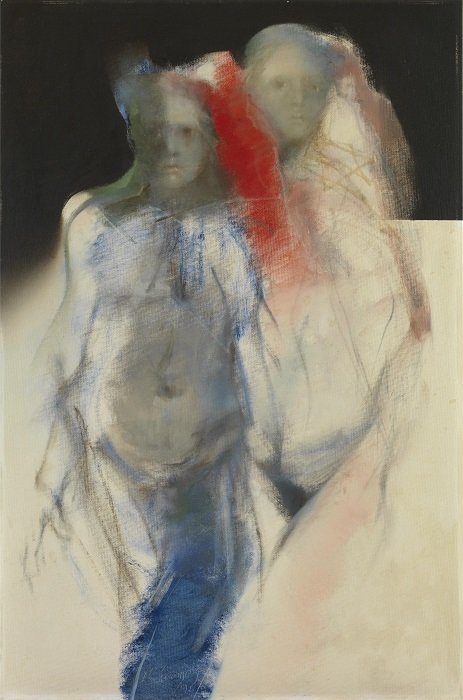Aristotle Solounias
-
Aristotle Solounias
1939 - 2009
Solounias was a sculptor and painter who successfully brought together various elements and techniques to create truly, timeless masterpieces.
His works are both a boldly personal expression and a universal truth hidden under a recognizable layer of form, texture, and line.
-
Aristotle Solounias, a painter and sculptor, was born in Athens, Greece in 1939 and was raised in the old center of ŌĆ£PlakaŌĆØ near the foothill of the ŌĆ£AcropolisŌĆØ.
In 1957 he went to the United States of America to attend Cornell University in Ithaca, NY, where he obtained a Βachelors Degree in Fine Arts. At the university he held several positions, such as assistant director of the Andrew White museum in the academic year 1962-63.
During that time period, having presented the first exhibitions of his work, he received his Masters degree in Fine Arts.
Upon completion of his academic studies he moved to Manhattan in New York and began his professional career in his own studio in the Bowery area.
He also worked as director of the Graphics Arts Department in the Museum of Fine Arts in Brooklyn. With the driving force being his connection to Classical Greek art, he repatriated to Greece and settled in his own studio in Athens in the ŌĆ£PhilopappouŌĆØ area, where he began a notable career in his homeland.
During the summer months, he worked on the island of Samos, the place of his ancestral origin, in the town of ŌĆ£PythagoreionŌĆØ where he founded in 1972 the Pythagorean Academy of Fine Arts.
It was accomplished with the cooperation of the Boston Academy of Art. The project ended abruptly in July 1974, due to the geopolitical turmoil in the area. Shortly thereafter, he became well known in the contemporary Greek Art world, holding exhibitions in major Athenian galleries, institutes and foundations.
He was featured in major newspapers, magazines and national Greek television. In 1972 he was commissioned to make a bronze relief for the National Railroad building in Athens. A big turning point in his career came in 1976 when he was given the commission to create two monumental sculptures (Aves) in Jeddah and Riyadh in Saudi Arabia.
He continued with numerous exhibitions in Greece and abroad as his work was featured in literary and scientific reviews and magazines over the years, while his unique style put an indelible mark in the art society. An enthusiast in his intrinsic solitude, he preferred observing life from the sidelines and focusing on art. He said and taught that being an artist is a way of life, a modus vivendi.
Devoted to his work, he strived to refine and perfect his technique while constantly experimenting with materials and procedures. Inspiration from classical antiquity, the renaissance and mannerism, as well as the most significant schools of the 19th and 20th centuries, marked the path of his aesthetic choices and living experience.
By continuous study and experimentation, he developed a unique medium for executing his special alla prima, glazing, chiaroscuro and sfumato techniques.
Concurrently, regarding his sculpting technique, and after working with the lost wax technique and using materials such as thin wire mesh, he turned to Vienna plaster where he worked on a system which he called the ŌĆ£Multiple Support SystemŌĆØ.
The main idea, using a new refining method, was to overcome the expectation that a piece of sculpture must hold a definite position. According to this, a piece of sculpture is supported from all possible angles making it impossible for artist or viewer to choose a single position in which it is to be seen.
Since 1993 and until the final years of his career, he put a halt in large-scale projects and only made professional appearances in exhibitions, due to serious health problems. He died in August 2009 at the age of 70.
In 2021, following a unanimous municipal decision, a square in the town of Pythagoreion in Samos was named ŌĆ£Aristotle Solounias SquareŌĆØ as a tribute to his contribution to the islandŌĆÖs cultural heritage.
Works of Aristotle Solounias are exhibited in Museums and held in Greek government buildings, foundations and private collections. Private collections of his work are also held in the U.S.A and many European countries including the Netherlands, France, Norway, Denmark, Sweden, the U.K, Cyprus as well as Australia and Saudi Arabia.
-
-
Artwork by Aristotle Solounias
Aristotle Solounias. Orpheus and Eurydice. Oil on canvas board. Orpheus and Eurydice. 51x67 cm.Aristotle Solounias. Abstract Figure. Oil on canvas. 22x35 cm.Aristotle Solounias. Perseus. Oil on canvas. 24x37 cm.Aristotle Solounias. Still Nature. Oil on canvas. 40x60 cm.Aristotle Solounias. Seascape. Oil on canvas. 28x35 cm. Aristotle Solounias. Oil on canvas. 60x81 cm.





